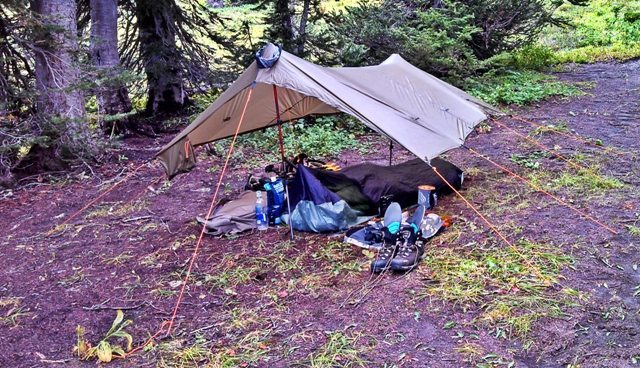
Floorless Phenomenon
by Brock Akers, Train to Hunt Director
When I show people some of my pictures from hunting trips that are not familiar with backpack hunting, their first comments are usually the same:
“You sleep in THAT?!?!”
They are shocked that I will spend a week in a shelter without a floor. As humans we like to be comfortable. A lot of people don’t find sleeping on the bare ground very comfortable. Now I will say that going floorless isn’t for everyone and not every hunting situation, but if you can wrap your mind around the idea, you will see the benefit from it immediately. Not only in comfort and size but also in weight savings.
When I discovered floorless shelters my first impression was “no way, not for me”. Then after the season I was looking for ways to lighten up my pack and I revisited the idea. I did some research and found that guys were having success with a tarp/bivy combo. I came around to the idea and before I could talk myself out of it, I pulled the trigger on a set up.
I like to run a bivy (a lightweight, waterproof shelter, and an alternative to a traditional tent) for a few reasons. I have woke up to bugs on the face netting many times. We all know mosquitoes can be pretty nasty in the summer and early fall. It also adds a little more protection against weather along with the potential to add some warmth to your set up. It’s been said that a bivy can add up to 10°F to your sleep system rating. Most of all it keeps me on my pad throughout the night. Without it, I would probably roll right out from underneath my tarp.
There is a plethora of choices from many different companies when it comes to bivy sacks ranging from simple seven-ounce minimalist bivys to more roomy, stand-alone verisons that can weigh upwards of 16 ounces or more. Make sure when selecting a bivy sack, that you choose one built with a high quality breathable material. This key for preventing condensation build up. (Keep in mind that a bivy sack is simply too confining for some people to sleep comfortably and is why some dismiss the idea. If your claustrophobic, then this shelter opton most likely isn’t for you.)
Choosing a tarp is different than choosing a bivy. You want a tarp that is built out of a durable material that can withstand wind and is big enough for your needs. Breathability isn’t something that I’m too concerned with here becasue once it’s pitched, it usually has significant airflow, therefore eliminating condensation. There are several good tarp manufacturers out there to pick from. I personally have had good success with the Kifaru shelters.
After you have purchased and received your set up, I would recommend doing a few things before hitting the high country with it. First, learn how to pitch it. One of the many pros to a tarp is the ability to pitch it in several different configurations. I would YouTube as many “how to’s” as you can and then practice them. You want to be 100% confident that whatever way you choose to set it up. Once you become proficient at the set up, you need to look at the seams and stitching and determine if they need seam sealed. Some come from the factory already sealed and others need to be done by you. This is an easy process and a quick Google search will yield many results.
When you’re in the mountains and setting up camp it doesn’t hurt to put a little thought into location and direction that you decide to pitch your set up. I have made the mistake of pitching mine on a low spot and when I crawled into bed for the night I had a wet quilt awaiting me. I have also made the mistake of pitching the opening of my tarp facing the prevailing wind, essentially turning it into a staked down parachute. Most tarps have a lot of engineering that went into their shape to buck the wind. Make sure you are pitching it so it’s doing what it was designed to do. Also, pick a spot that is slightly elevated or if that isn’t possible, cut some trenches with the heel of your boot around the perimeter. You would be amazed and what a little groove in the dirt will do to divert water away.
I know going floorless just adds to the already long list of shelter options, but I truly believe a bivy/tarp option should be a front runner when choosing an early season set up. Branch out of your comfort zone and give it a try. You never know, you might find yourself shaving several pounds off your pack this fall.
Discuss this article here



















